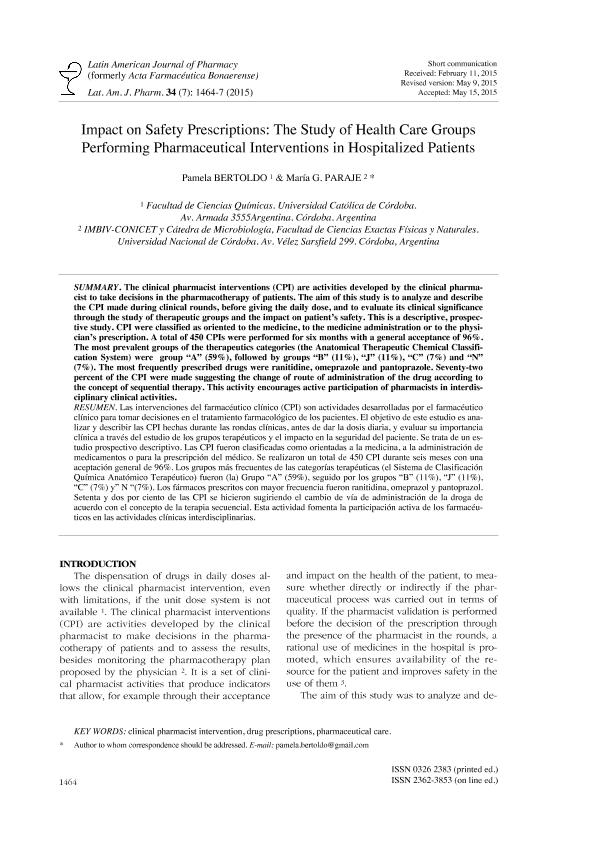Artículo
The clinical pharmacist interventions (CPI) are activities developed by the clinical pharmacist to take decisions in the pharmacotherapy of patients. The aim of this study is to analyze and describe the CPI made during clinical rounds, before giving the daily dose, and to evaluate its clinical significance through the study of therapeutic groups and the impact on patient’s safety. This is a descriptive, prospective study. CPI were classified as oriented to the medicine, to the medicine administration or to the physician’s prescription. A total of 450 CPIs were performed for six months with a general acceptance of 96%. The most prevalent groups of the therapeutics categories (the Anatomical Therapeutic Chemical Classification System) were group “A” (59%), followed by groups “B” (11%), “J” (11%), “C” (7%) and “N” (7%). The most frequently prescribed drugs were ranitidine, omeprazole and pantoprazole. Seventy-two percent of the CPI were made suggesting the change of route of administration of the drug according to the concept of sequential therapy. This activity encourages active participation of pharmacists in interdisciplinary clinical activities. Las intervenciones del farmacéutico clínico (CPI) son actividades desarrolladas por el farmacéutico clínico para tomar decisiones en el tratamiento farmacológico de los pacientes. El objetivo de este estudio es analizar y describir las CPI hechas durante las rondas clínicas, antes de dar la dosis diaria, y evaluar su importancia clínica a través del estudio de los grupos terapéuticos y el impacto en la seguridad del paciente. Se trata de un estudio prospectivo descriptivo. Las CPI fueron clasificadas como orientadas a la medicina, a la administración de medicamentos o para la prescripción del médico. Se realizaron un total de 450 CPI durante seis meses con una aceptación general de 96%. Los grupos más frecuentes de las categorías terapéuticas (el Sistema de Clasificación Química Anatómico Terapéutico) fueron (la) Grupo “A” (59%), seguido por los grupos “B” (11%), “J” (11%), “C” (7%) y” N “(7%). Los fármacos prescritos con mayor frecuencia fueron ranitidina, omeprazol y pantoprazol. Setenta y dos por ciento de las CPI se hicieron sugiriendo el cambio de vía de administración de la droga de acuerdo con el concepto de la terapia secuencial. Esta actividad fomenta la participación activa de los farmacéuticos en las actividades clínicas interdisciplinarias.
Impact on safety prescriptions: The study of health care groups performing pharmaceutical interventions in hospitalized patients
Fecha de publicación:
09/2015
Editorial:
Colegio Farmaceuticos Provincia de Buenos Aires
Revista:
Acta Farm. Bonaerense
ISSN:
0326-2383
e-ISSN:
2362-3853
Idioma:
Inglés
Tipo de recurso:
Artículo publicado
Clasificación temática:
Resumen
Archivos asociados
Licencia
Identificadores
Colecciones
Articulos(IMBIV)
Articulos de INST.MULTIDISCIPL.DE BIOLOGIA VEGETAL (P)
Articulos de INST.MULTIDISCIPL.DE BIOLOGIA VEGETAL (P)
Citación
Bertoldo, Pamela; Paraje, Maria Gabriela; Impact on safety prescriptions: The study of health care groups performing pharmaceutical interventions in hospitalized patients; Colegio Farmaceuticos Provincia de Buenos Aires; Acta Farm. Bonaerense; 34; 7; 9-2015; 1464-1467
Compartir




